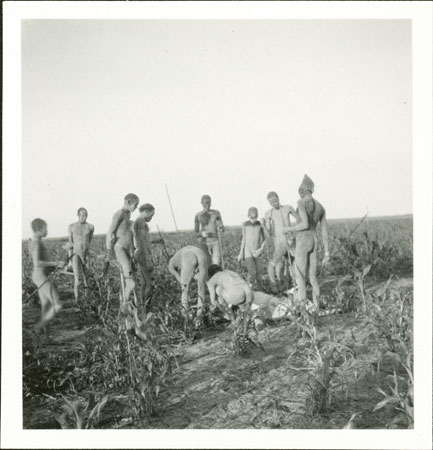Nuer ox sacrifice

56 x 54 mm | Print gelatin silver
There are records relating to alternative images that we do not have scans for in the database:
1998.346.279.1 - Negative film nitrate , (58 x 55 mm )
1998.346.279.1 - Negative film nitrate , (58 x 55 mm )
Date of Print:
Unknown
Previous PRM Number:
EP.N.279
Previous Other Number:
?02 2
Accession Number:
1998.346.279.2
Description:
A group of men surround a white ox that has been sacrificed to God in a garden after the death of an individual due to lightning strike (a fairly common occurance).
Such individuals are considered colwic, spirits of the above that were once people, taken directly by God.
This intervention by the divine is considered so dangerous to all associated with the colwic that sacrifice is made by all concerned, and a shrine erected with offerings.
It is possible that this event is associated with the one described by Evans-Pritchard that he witnessed in 1936 for a woman called Nyakewa in western Nuerland, for he does not mentioned having witnessed another.
Photographer:
Edward Evan Evans-Pritchard
Date of Photo:
?1936
Region:
[Southern Sudan] western Nuerland
Group:
Nuer ?Leek
PRM Source:
Edward Evan Evans-Pritchard
Acquired:
Donated 1966
Other Owners:
E. E. Evans-Pritchard Collection
Class:
Religion , Ritual , Agriculture and Horticulture
Keyword:
Animal Cattle , Field
Activity:
Ritual Activity
Event:
Sacrifice
Documentation:
Original catalogue lists in Manuscript Collections. Additional material in related documents files. [CM 27/9/2005]
Primary Documentation:
Accession Book Entry: [p.
98] 1966.27 [1 - 24] G[ift] PROFESSOR E.
E.
EVANS-PRITCHARD; INST.
OF SOCIAL ANTHROPOLOGY, 51 BANBURY RD.
OXFORD 1966.27.17 S.
SUDAN.
NUER TRIBE.
Box of negatives each in separate envelope, labelled.
(some missing).
Nos.
1 - 213.
(prints in box 1966.27.18)...1966.27.18 S.
SUDAN.
NUER TRIBE.
Box of prints each in separate envelope.
Nos.
1 - 213.
(negatives in 1966.27.17.)
Note on print reverse ms pencil - "02 2 Col wic"
Note on print reverse ms pencil - "02 2 Col wic"
Recorder:
Christopher Morton [28/4/2004] [Southern Sudan Project]

